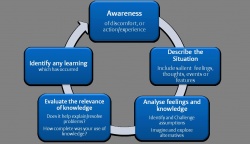Opportunity to reflect!: Difference between revisions
Aharon Love (talk | contribs) No edit summary |
Aharon Love (talk | contribs) No edit summary |
||
| Line 1: | Line 1: | ||
[[Image:Atkins and Murphy.JPG|thumb|left|250px|Atkins & Murphy Reflection Model]] | [[Image:Atkins and Murphy.JPG|thumb|left|250px|Atkins & Murphy Reflection Model]] | ||
‘Reflective practice is a process by which you stop and think about your practice, consciously analyse your decision making and draw on theory and relate it to what you do in practice’ ( | ‘Reflective practice is a process by which you stop and think about your practice, consciously analyse your decision making and draw on theory and relate it to what you do in practice’<ref name="ref how">The Chartered Society of Physiotherapy. What is Reflective Practice and how do I do it? http://www.csp.org.uk/faqs/cpd/what-reflectice-practice-how-do-i-do-it (accessed 12 Nov 2012).</ref>. After you have read this opinion piece you have the opportunity to reflect and express your opinions, feelings, emotions, agreements and/or disagreements with our piece, by using the simple model below from Atkins & Murphy<ref name="Atkins">Atkins S, Murphy K. Reflective Practice. Nursing Standard 1994;8:49-56.</ref>. This will help you experience a deeper and more meaningful level of reflection. Allied health professionals bodies have given recognition to continued professional development and stated that it is fundamental to the development of all health and social care practitioners and to the enhancement of quality patient care within the MDT<ref name="CPD">The Chartered Society of Physiotherapy. A joint statement on continuing professional development for health and social care practitioners. http://www.csp.org.uk/publications/joint-statement-continuing-professional-development-health-social-care-practitioners (accessed 12 Nov 2012).</ref>. Reflection gives you the opportunity to advance your knowledge and help understand what you have learned and how you will apply this learning in the future. <br> | ||
<br> | |||
== References == | == References == | ||
<references /> | <references /> | ||
Latest revision as of 15:52, 15 November 2012
‘Reflective practice is a process by which you stop and think about your practice, consciously analyse your decision making and draw on theory and relate it to what you do in practice’[1]. After you have read this opinion piece you have the opportunity to reflect and express your opinions, feelings, emotions, agreements and/or disagreements with our piece, by using the simple model below from Atkins & Murphy[2]. This will help you experience a deeper and more meaningful level of reflection. Allied health professionals bodies have given recognition to continued professional development and stated that it is fundamental to the development of all health and social care practitioners and to the enhancement of quality patient care within the MDT[3]. Reflection gives you the opportunity to advance your knowledge and help understand what you have learned and how you will apply this learning in the future.
References[edit | edit source]
- ↑ The Chartered Society of Physiotherapy. What is Reflective Practice and how do I do it? http://www.csp.org.uk/faqs/cpd/what-reflectice-practice-how-do-i-do-it (accessed 12 Nov 2012).
- ↑ Atkins S, Murphy K. Reflective Practice. Nursing Standard 1994;8:49-56.
- ↑ The Chartered Society of Physiotherapy. A joint statement on continuing professional development for health and social care practitioners. http://www.csp.org.uk/publications/joint-statement-continuing-professional-development-health-social-care-practitioners (accessed 12 Nov 2012).







